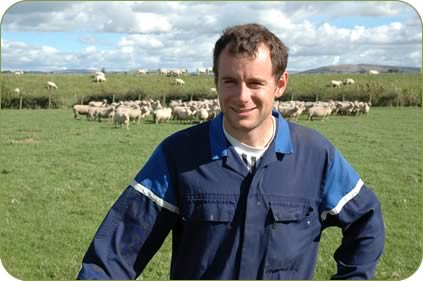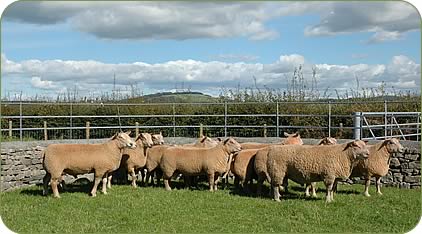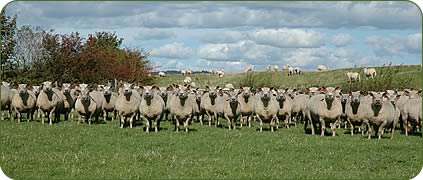 |
|||||||||
|
|||||||||||||||||||
| news index | The Charollais weighs up
The Charollais is able to achieve carcase weights at the required age and lamb easily on hoggs and as a result is likely to be in increasing demand with changes to farm support payments. This is why south Cumbrian livestock producers brothers Richard and Charles Geldard and their parents John and Rachel have maintained their pedigree Charollais flock since 1982. “We have tried various continental breeds but we found the Charollais is able to give us the weight we want at the required age and the Charollais has come into its own through ease of lambing, particularly when lambing hoggs. “It’s worth a lot to be able to lamb the hoggs without problems. A lot of our customers buy them for that reason alone because producers don’t want to damage the hoggs.” The rams are proving a popular crossing sire onto Mule cross Texel and Suffolk cross Mule ewes, helping to maintain a good lambing percentage and to maintain easy lambing.
The Geldards imported their first three pedigree Charollais from France in 1982 when they farmed in the Lake District near Ambleside and they have been breeding them ever since. “The main concept behind keeping them was to breed good quality commercial rams for the commercial sheep farmer and if we are able to breed rams that are good enough for pedigree breeders that’s a bonus,” said Richard Geldard who looks after the day to day running of Low Foulshaw Farm, near Levens, Kendal with his brother Charles. The family now runs 120 pedigree Charollais ewes in their Wraycastle flock alongside around 900 Lleyn ewes. Two hundred of the Lleyn ewes are crossed with the Charollais to produce a good cross-bred lamb which sells well in the local market and the remainder of the Lleyns are bred pure. The farm’s 500 acres of good grass growing land at sea level alongside the River Kent estuary also carries a herd of 130 Limousin cross suckler cows put back to the Charolais bull with bulls finished off the farm at around 12 months old and heifers at between 16 months and two years old. Against a background of the Holstein influence on the suckler cow, they have been experimenting with Stabiliser cattle with calves born over the last two years through an ET project and now 60 of the best sucklers are being put to the Stabiliser bull. Up to 250 store cattle are bought in each year for finishing, although this might be reduced with CAP reforms and 28,000 free range hens are kept for egg production
The pedigree Charollais flock is AId in mid July and given one chance afterwards to run with the ram with the aim of lambing in early December. The ewes are scanned in September and any which are not in lamb are served to lamb in March. March-born ram lambs are generally run on to be sold as shearlings while the December-born crop are sold as lambs, weighing 90kg-plus. Tups are sold from July through the ring at Worcester and Lanark and at Builth Wells in September – a sale venue for more than 20 years for the flock - as well as privately from the farm through to the end of October to hill farmers. Buyers keep coming back for then Wraycastle rams. This year at Builth Wells the flock’s entry of eight ram lambs averaged £405 while 10 shearlings levelled at £720. “We are seeing more people looking towards the Charollais in the north of England,” said Richard Geldard. “Traditionally, it has been a breed which has been very popular in the Midlands and the south of the country but as we are moving towards a decoupled agriculture, producers are looking more at the easy-care concept of keeping sheep and easy lambing is part and parcel of that. “We have found in the last few years that the rams have been more sought-after in the north and we are selling more direct from the farm.” Richard believes that sheep will continue to have an important part to play in the new regime of farm support payments with many farmers looking at sheep as an alternative to other livestock enterprises and to meet cross-compliance requirements. The Geldards have aimed to breed their Charollais with the qualities required by the commercial producer – conformation, hardiness and easy lambing. Rams are bred with more head cover for lambing outdoors. As well as being good-skinned sheep, the Geldards have found the breed also has a natural resistance to worms, which not only helps with problems of anthelmintic resistance but keeps finished lambs cleaner to meet current MHS regulations. The pedigree Charollais ewes are run commercially outdoors and housed a month before lambing during which time they are fed ewe rolls and haylage. The Geldards are happy with a lambing percentage of 180 for the pedigree flock although the 2003 lambing was exceptional with two lambs per ewe which most ewes can rear quite easily because of their milkiness. They have experienced a demand for in-lamb females, selling them in October to new flockmasters. The Lleyns crossed with the Charollais lamb in March and the ewes are turned out after lambing. Weaning is in July and the majority of the lambs sold prime are drawn in August and September and sold either through Lancaster mart as well as up to 10 lambs a week through Plumgarths Farm Shop, run by John and Rachel Geldard as a separate business with partners. The cross-bred lambs average 42-44kg liveweight and kill-out at around 50 per cent recently making in excess of £50 a head. Lambs culled from the pedigree flock are in demand for the Easter market. Culling is hard with only the best lambs being kept for breeding. When selecting rams for the pedigree flock, they look for hardy, fleshy rams. Of the current four stock rams, Harmby Moor Copello had bred among his two crops of lambs the 2004 Worcester society premier sale champion which sold for 3,500gns as well as the Lanark champion which made 1,800gns. A twin brother to the Lanark champion made 2,100gns to an Orkney breeder and another Copello son sold in Worcester for 3,100gns to a breeder from Northern Ireland. Lowyer Daredevil has passed on his good conformation and fleshing abilities to his progeny while Southam Dynamite, a stretchy ram has produced long-bodies lambs which are very correct on their feet. The ram lamb Logie Durno Einstein was bought this year as a lamb in Worcester. © Copyright 2005 Jennifer MacKenzie All Rights Reserved. |
||||||||||||||||||

|
|
||||||||||||||||||
| home | agri-services | pedigree
pen | news | dairy | beef | machinery bps | property | organisations | site map |
|||||||||||||||||||

Article by
Jennifer MacKenzie
Breed Stalwarts Clinch Top Honours at Skipton Charollais Show


